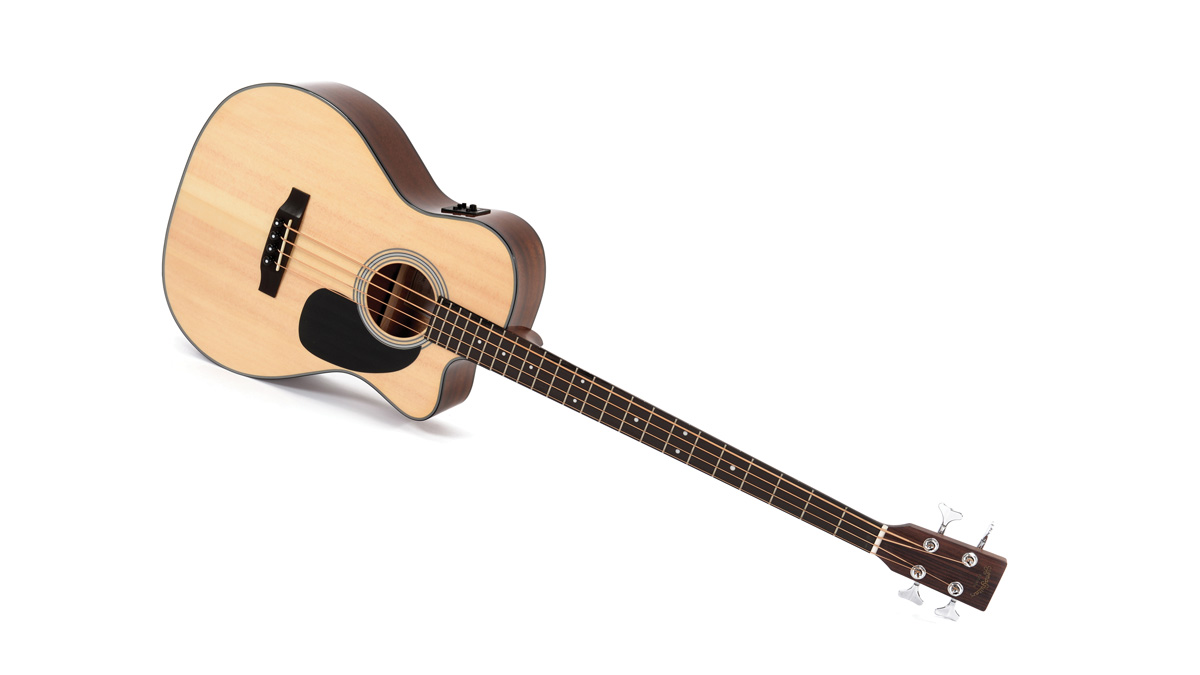MusicRadar Verdict
You get a lot of bass for your buck here; invest with confidence.
Pros
- +
Outstanding value, impressive tones, nice fingerboard.
Cons
- -
Neck finish could be zippier.
MusicRadar's got your back
The venerable Sigma brand has been a fixture of the acoustic world for decades, so we’re always happy to give the company’s basses a try, particularly as the new, eco-friendly models - which avoid the use of rosewood - can be yours for a relatively trifling sum.
Equipped with performer-friendly features and aesthetically pleasing to the eye, the (deep breath) BMC 1STE+ looks pretty tasty out of the box. How does it perform in the tough world of low-to mid-price basses?
Build
Physically, this bass is familiar. There’s a set neck, dovetailed into the body, and a sitka spruce top; mahogany has been used for the back, sides, neck and bridge. The 23-fret (yep) fingerboard is made of Micarta, a composite that is for all intents and purposes the same as a dark hardwood such as ebony.
The machine heads are Sigma chrome, and while unremarkable in appearance do a solid job with no hint at slippage. The details are mostly in place, with a bone nut and bridge saddles, and there’s a pop-out battery compartment next to the rear jack socket. The only omission is a front strap button - a minor detail, you might think, until you try and play the bass on a strap. Warning: power drills and bass guitars do not combine well.
Sounds
D’Addario PBB170 phosphor bronze strings immediately hit you with the zingy, trebly, throaty tone that all acoustic basses seem to have. Mids are in abundance, and the bronze clank will cut through pretty much any band mix.
There’s some warmth, of course, but there’s no escaping the standard acoustic mids; an interesting side-effect is the generous resonance of the acoustic body. If all this doesn’t add up to the sound you’re after, whip ’em off and get some flatwounds on instead, but more or less any reasonable tone can be attained when you plug in and tweak the onboard EQ and your amp controls, we reckon.
The Fishman Isys+ pickup and preamp system is tried and tested, and offers the basic features that you’ll need. A two-band EQ pushes the top and bottom end acceptably far. The bass end in particular will need a push if you’re playing to anything bigger than a small room. The tuner and low-battery LED are obviously useful, and the phase switch, while rarely used in practice, will come in handy if you experience feedback issues.
Want all the hottest music and gear news, reviews, deals, features and more, direct to your inbox? Sign up here.
In terms of playability, this bass scores highly. The neck feels and looks long, although it’s a standard 34” scale, but it balances just fine on your lap. On a strap, it’ll depend where you (or your local guitar shop, if you’re clever) affix a front strap button. Up to the 17th fret, everything is fully accessible; beyond that it’s a stretch, and hitting a second octave on the strings when there’s ‘only’ 23 frets to play with will require a pretty solid string-bend.
Some may be sceptical about fretting against anything but wood, but environmentally conscious types can rejoice - the fact is that the Micarta fingerboard feels great, with no difference in feel to a ‘real’ board that we could detect; our only slight whinge is that the rear neck finish is a touch too grippy for our liking. Still, that’s traditional guitar design for you, and you probably won’t be playing John Myung-style shred solos on this instrument anyway.
We regularly bore our patient readers with our enthusiasm about the current era of cheap-but-good bass guitars (thanks for bearing with us), which is down to the fact that we started playing in the 80s, when we were surrounded by useless, cut-price planks disguised as basses. Thanks to the rise of design and manufacturing tech, plus various contributory factors such as globalisation - which our grade E in O Level Economics renders us unable to grasp fully - those days are gone.
Affordable acoustic basses such as this one are now as good and as prevalent as their solid-bodied equivalents. Of course, you may or may not regard £429 as an affordable sum, and for that amount of money you still have every right to expect decent quality. You’ll get it here, though, so do investigate.
